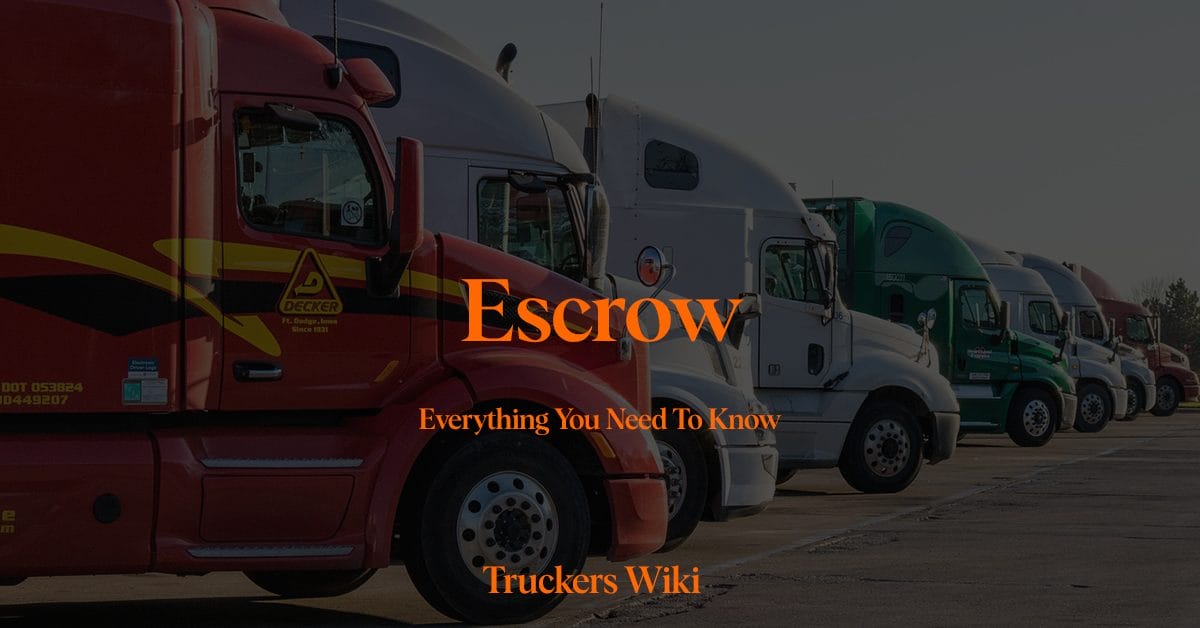
Table of Contents
What is Escrow in Trucking
Escrow in trucking refers to a financial arrangement where truck drivers or owner-operators set aside a portion of their income with their employing company. This money is held in an account to cover potential future expenses or liabilities related to truck operation and maintenance or in case a driver incurs certain liabilities or expenses and then quits the job.
Purpose of Escrow
The primary purpose of an escrow account in trucking is to provide a financial buffer for various expenses. These can include routine maintenance and repairs, insurance deductibles, and coverage for damages that may occur during transport. Escrow can also be used to settle end-of-lease expenses or to ensure compliance with lease agreements.
How Escrow Works in Trucking
Typically, a predetermined amount is deducted from the driver’s earnings and placed into the escrow account. The specific terms, such as the amount and frequency of deductions, are agreed upon in the lease or employment contract. This proactive approach to saving helps drivers manage large, unexpected expenses without the stress of immediate out-of-pocket payments.
Trucking Escrow Amounts
Trucking companies can require an escrow on a list of things. Starting with escrow for in-truck tablet which is usually $150, rider/pet at about $350, and truck escrow at about $1500 deducted weekly at $150 till the full amount is reached.
Some companies have no escrow, some have higher priced ones.
Refunds from Escrow Accounts
In many cases, if a driver ends their employment or lease agreement and hasn’t utilized all the funds in their escrow account, the remaining balance is refunded. However, the terms of the refund are usually outlined in the contract, and drivers should familiarize themselves with these specifics to understand when and how they can expect any refund.
Typically the escrow is refunded in 30 to 50 days after the driver has ended his employment with the company.
Common Practice in the Industry is as Follows
Standard Holding Period
Many companies have a standard holding period after a driver quits, during which the escrow money is retained. This period can range from a few weeks to several months. The purpose is to ensure that all outstanding expenses or liabilities related to the driver’s tenure are covered.
Final Settlement
After the holding period, the company will usually conduct a final settlement. This involves calculating any expenses, damages, or unpaid fees that need to be covered by the escrow funds. Once these calculations are completed, any remaining balance in the escrow account is typically returned to the driver.
Contractual Variations
It’s important to note that the specific terms can vary widely between companies. Some might return the escrow funds quickly, while others may have longer holding periods or additional conditions that need to be met before the funds are released.
Legal and Regulatory Constraints
There may also be legal or regulatory constraints that determine the minimum or maximum duration for which escrow funds can be held. Drivers should check if there are any such regulations in their state or country.
Dispute Resolution
In case of disputes over the escrow funds, most contracts have a dispute resolution process outlined. Drivers should be aware of this process and the steps they need to take if they disagree.
Driver Escrow Deductions
Damage to Equipment: If a driver damages a truck or other equipment, the company can use the escrow funds to cover repair costs.
Traffic Fines and Violations: In cases where a driver receives traffic fines or incurs other violations that are the responsibility of the employer, the escrow can be used to pay these fines.
Unfulfilled Contractual Obligations: If a driver leaves before fulfilling their contractual obligations, such as a minimum term of service, the escrow can compensate the company for losses incurred due to early termination.
End-of-Lease Expenses: For drivers who lease a truck from the company, the escrow might cover end-of-lease expenses, such as cleaning or repair costs to return the truck in the agreed-upon condition.
Insurance Deductibles: In some cases, escrow funds may be used to cover insurance deductibles for claims made during the driver’s employment.
Escrow in Practice
In practice, companies may try to keep the escrow with no legal standing, in which case the driver should reach out to legal support, most often attorney general consumer affairs. It depends from state to state. Below you will find a link to FMCSA NCCDB where you can file a complaint if you have been wronged.
Benefits of Escrow for Drivers
While it might initially seem like an additional cost, escrow accounts offer significant benefits. They help drivers manage and plan for significant expenses related to their trucks, such as repairs or insurance claims. This financial planning tool is particularly advantageous for independent operators who may not have immediate access to large sums of money for unexpected costs.
Learn about Trucks & Trailers used in the trucking industry here.
Regulations and Transparency
Regulations often govern the handling of escrow funds to protect the interests of drivers. Companies are typically required to maintain transparency in how these funds are managed, used, and refunded. Drivers should ensure they understand the terms of their escrow agreements and that their employer is complying with relevant regulations.
Managing Escrow Funds
Effective management of escrow funds is key. Drivers and trucking professionals should regularly review their escrow account statements to track deductions and expenditures. This vigilance ensures that funds are being used appropriately and that the account is adequately funded to cover anticipated expenses.
Learn about Breakdown pay here.
Learn about Lumper Fee here.
Learn about Accessorial Charges here.
External Links
National Consumer Complaint Database: NCCDB – file a complaint with FMCSA – click here.
Just Answer Legal – question about owed escrow to a truck driver – click here.
Last modified: February 27, 2024

